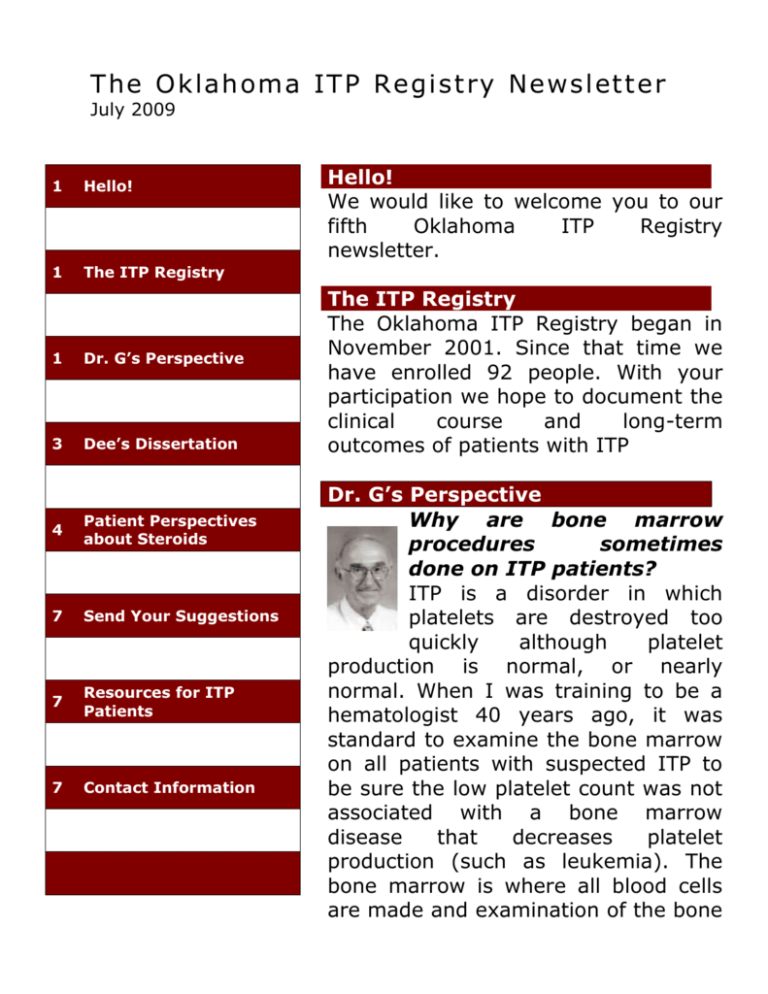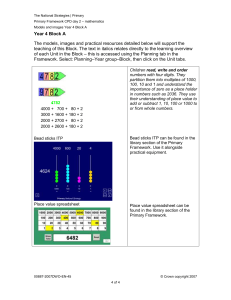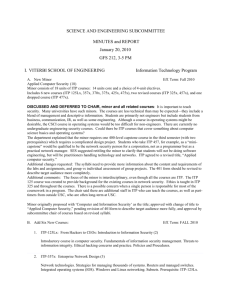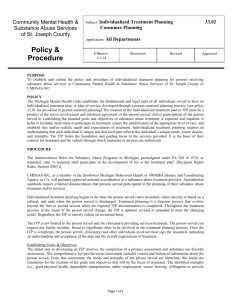The Oklahoma ITP Registry Newsletter, July 2009
advertisement

T he Ok lahoma ITP Reg is t ry N ew s let t er July 2009 1 Hello! 1 The ITP Registry 1 Dr. G’s Perspective 3 Dee’s Dissertation 4 Patient Perspectives about Steroids 7 Send Your Suggestions 7 Resources for ITP Patients 7 Contact Information Hello! We would like to welcome you to our fifth Oklahoma ITP Registry newsletter. The ITP Registry The Oklahoma ITP Registry began in November 2001. Since that time we have enrolled 92 people. With your participation we hope to document the clinical course and long-term outcomes of patients with ITP Dr. G’s Perspective Why are bone marrow procedures sometimes done on ITP patients? ITP is a disorder in which platelets are destroyed too quickly although platelet production is normal, or nearly normal. When I was training to be a hematologist 40 years ago, it was standard to examine the bone marrow on all patients with suspected ITP to be sure the low platelet count was not associated with a bone marrow disease that decreases platelet production (such as leukemia). The bone marrow is where all blood cells are made and examination of the bone ITP Registry Newsletter page 2 marrow can provide confidence that blood cell production is normal. Although obtaining a marrow sample from the hip bone is painful, it is a safe. In the past 15 years it has become clear that in most patients with suspected ITP, careful examination of the blood can provide confidence that platelet production is normal and the bone marrow does not have to be examined. However in some patients examination of the blood is not so clear. If some abnormalities of the white blood cells and red blood cells are present; then direct examination of the bone marrow is essential. Examination of the bone marrow is also appropriate when there is no response to treatments and in older patients, such as patients over 60 years old, when disorders of platelet production are more common. Are there any adverse side effects of the new ITP drug, romiplostim, that was discussed in the last newsletter? Romiplostim (brand name, Nplate) and eltrombopag (brand name, Promacta) are very effective new agents that can increase platelet production and platelet counts in most patients with ITP with very few side effects. In our experience with 10 patients over the past 7 years, we have not observed any important side effects from romiplostim. However some patients have had problems that required the treatment to be stopped. In a very few patients the increase of platelet production in the bone marrow has been associated with an increase of the tissue fibers that form the structure of the marrow (called ‘reticulin’), which is evident from a bone marrow biopsy. The problem has improved when romiplostim was stopped. Increase of reticulin fibers has also occurred in a few patients treated with eltrombopag. To document whether this may be more common than we now suspect, there are current studies doing repeated bone marrow tests on patients receiving romiplostim. Because platelet counts can go very high as the dose of romiplostim is being adjusted, there has been concern for risk of blood clots. However this has not been observed. Finally, when patients stop romiplostim, the platelet count may fall to even lower levels than were present before treatment. However this is temporary and platelet counts recover to their pre-treatment level within a few days. ITP Registry Newsletter page 3 Because these new drugs are so powerful and so effective, there has been careful attention to the potential risks. But so far, they are impressively safe treatments for ITP. Is romiplostim safe for everyone? The answer is “yes”, with a few exceptions. Romiplostim has not been given to pregnant women and there is no information about potential risks for the fetus; therefore romiplostim should not be used in a woman who is pregnant or breastfeeding. Also the experience with romiplostim is very limited in infants. However, even though romiplostim is safe for almost everyone, it may not be appropriate treatment for every patient with ITP. It is most important for patients who have failed traditional treatments, such as a short course of steroids, splenectomy, and rituximab. These treatments are important to try first because they can stop the ITP, correct the platelet count, and the patient may need no further treatment. The effect of romiplostim is different. It does not change the ITP; it only increases the platelet counts while the ITP persists. Therefore romiplostim and eltrombopag must be taken forever. This is a big commitment and a very big expense. Dee’s Dissertation Dee has recently finished her dissertation to receive her Ph.D. in epidemiology (the study of disease). To graduate, she had to complete an extensive research project, called a dissertation. Dee chose ITP as the topic for her study. Introduction: Idiopathic (also known as immune and autoimmune) thrombocytopenic purpura (ITP) is an autoimmune blood disorder defined by a low platelet count. That means a person with ITP is at an increased risk for bleeding even with minimal trauma. Routine things can no longer be taken for granted. Parents of toddlers with ITP are told to watch their child carefully and make sure they avoid head injuries. Children and teenagers diagnosed with ITP are often told they can only play non-contact sports. An adult patient with ITP ITP Registry Newsletter page 4 might have to receive treatment to temporarily raise their platelet count before a dental cleaning or a dermatologist visit. A question patients and parents of patients with ITP often wonder is, how many other people have ITP? The number of people living with a disease is called the prevalence of the disease. There have only been two previous studies completed in the US looking at the prevalence of ITP. However results from these studies may or may not apply to the general population. Both of these studies only included persons who were privately insured. The goal of the present study was to determine the prevalence of ITP (regardless of age or insurance status) in the state of Oklahoma. Methods: De-identified data (no names or information that could link back to an individual person) was obtained from hematologists in the state of Oklahoma. In November 2007, there were 93 hematologists in Oklahoma who cared for ITP patients. Our preliminary data documented that hematologists saw > 92% of all patients with ITP and that primary care physicians in Oklahoma reported they were ‘likely’ to refer 85% of patients with platelet counts <30,000/μL and bleeding symptoms to a hematologist. All hematologists were asked to provide information on all (new and existing) ITP patients seen from 1/03-12/04. Ninety-five percent (88/93) of the hematologists in the state were able to provide these data. Prevalence estimates were calculated separately for children (age <16 years) and adults (age > 16 years). Results: The average annual prevalence estimate for children was 8.1 per 100,000 children-so for every 100,000 children in Oklahoma there are 8.1 children who have ITP; the estimate for adults was 12.1 per 100,000 adults-so for every 100,000 adults in Oklahoma there are 12.1 with ITP. Children were 51% female and the average age was 6 years; adults were 57% female and the average age was 55 years. ITP Registry Newsletter page 5 Conclusion: This is the first population based study to determine the prevalence of ITP for an entire defined geographic region, regardless of insurance status and age. These are the most generalizable estimates of prevalence currently available on which to determine the burden of ITP. This information is important not only for patients with ITP, but also pharmaceutical companies, regulatory agencies, and heath care authorities. Comparison of Patient and Physician Perspectives Results! The results are in from the study that our student Jacqueline designed. Thank you to everyone who completed the survey! As you may know, steroids are standard initial treatment for patients with idiopathic thrombocytopenic purpura (ITP), but side effects may become severe. We hypothesized that patients with ITP may be more concerned about the side effects of steroid treatment and less concerned about the risk for serious bleeding than their hematologists. We surveyed 80 patients in the Oklahoma ITP Registry and all the hematologists in the State of Oklahoma with questions about the occurrence and severity of 18 steroid side effects and risks for serious bleeding. Response rates were 80% (patient) and 71% (hematologists). The responses of patients and hematologists were significantly different (indicated by stars on the graph on the next page) regarding the frequency of severe steroid side effects The survey specifically asked patients and hematologists about 38 different side effects related to steroid treatment, grouped into the 18 categories The numbers in the graph correspond to the numbers of each corticosteroid side effect listed next to the graph. The difference between the patients’ responses and the physicians’ responses was statistically significant for 14 out of 18 categories. Of those 14 significant differences, 13 reported the patients experienced a lot more bother from that category of side effects than their hematologist recognized. ITP Registry Newsletter page 6 80 70 * Patient Hematologist Percent 60 50 * 40 30 20 ** 10 0 1 2 3 4 5 * * * * * * * * * * * * * * 6 7 *8 9 10 11 12 13 14 15 16 17 18 * Side Effects 1. Moon face, bloating, swelling 2. Weight gain/increased appetite 3. Hair loss 4. Acne 5. Stretch marks 6. Insomnia, restlessness, and/or trouble sleeping 7. Anxiety and/or nervousness 8. Depression and/or stress 9. Anger and/or irritability 10. Generalized weakness, fatigue 11. Muscle weakness 12. Body pain (joint stiffness, muscle cramps, osteoporosis) 13. Hot flushes and/or sweating 14. Visual problems (light sensitivity/ decreased visual acuity) 15. Nausea, upset stomach, vomiting, diarrhea 16. Dizziness, headaches 17. Trouble with blood glucose levels, diabetes 18. High blood pressure In addition, significantly fewer patients (31%) with platelet counts <10,000/µL reported they had been very worried about serious bleeding, compared to 69% and 93% of hematologists, responding to two comparable case scenarios. Physicians need patients to communicate with them so that they know how much a side effect is bothering their patients. Just as physicians must educate patients about their illness, patients have a responsibility to educate their physicians about the problems they are experiencing. We hope this study will be influential in the ways that ITP patients and physicians communicate and the way that steroids are prescribed for ITP patients in the future. For the full results of this study, use the citation below or contact our office. Corticosteroid side-effects and risk for bleeding in immune thrombocytopenic purpura: patient and hematologist perspectives. Guidry JA, George JN, Vesely SK, Kennison SM, Terrell DR. Eur J Haematol. 2009. ITP Registry Newsletter page 7 Send Your Suggestions Is there anything you’d like to see in the next newsletter? We’d like to hear from you! Please contact us if you have any suggestions as to what you would like to see in this newsletter in the future either by emailing Dee Terrell at deeterrell@ouhsc.edu or calling at (405)271-8001 extension 48386. Resources for ITP Patients Visit our website, Platelets on the Internet, at http://www.ouhsc.edu/platelets. There is also an informative website from the United Kingdom you can visit at www.itpsupport.org.uk. This site includes a support group with newsletters, publications, and information on ITP. Dr. George contributes “An American Perspective” found on this page, where you can find additional topics about ITP. www.itpsupport.org.uk/american.htm Contact Information Phone: (405) 271-4222 Mailing address: James George, MD Attention: ITP Registry OU Health Sciences Center Hematology-Oncology Section P.O. Box 26901 CHB #333 Oklahoma City, OK 73126 Website: http://www.ouhsc.edu/platelets The Oklahoma ITP Registry James George, MD OU Health Sciences Center Hematology-Oncology Section P.O. Box 26901 Oklahoma City, OK 73126





